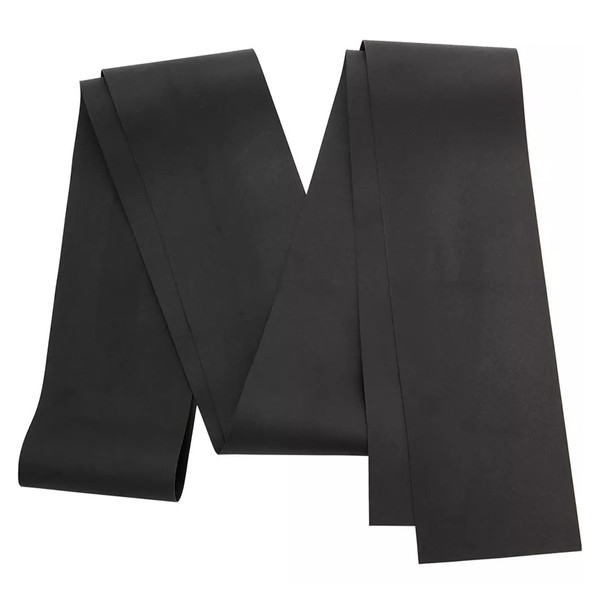
A Guide To Using Resistance Bands
It’s A Form Of Resistance Training
A resistance band may look fairly benign, but it works the body in a similar way to a pair of dumbbells, so it’ll count towards your weekly strength training quota. However, as Loi Jordan, group fitness manager at Equinox explains, a band – whether used on your arms or legs – has a real advantage over free weights. “Where weights work the muscle during the concentric (i.e. work) phase of an exercise, with resistance bands you are working the entire range of an exercise, making it a seriously powerful and effective workout.” As Loi explains, with dumbbells, you work against gravity, which makes the lowering phase easier, but with a band, you get resistance in both directions, resulting in constant tension on the muscle you are working. “A band may seem lightweight but pick one up and you’ll feel the burn instantly,” she adds.
They Can Help Build A Stronger Body
Used originally for muscle rehabilitation, resistance bands will not only provide a killer workout, but will also help improve your coordination and motor control. You can even use a band as part of your warm-up and cool-down, and they are particularly effective for keen runners. If your typical pre-run warm-up consists of movement such as squats, hamstring or calf stretches, try adding a resistance band to increase the intensity and to isolate key muscles such as your glutes, which are vital for hip stability when running. As Pilates instructor Nathalie Clough adds: “A resistance band is a great way to focus on specific body parts. For example, the glutes are notoriously hard to activate and tone, but with a band you can better feel the connection and strengthen muscles in the area.” At the same time, the type of muscle strength bands provide is different from traditional weight training. “When your muscles are worked against the resistance of a band, they are stretched and lengthened. It is exactly this science that’s behind that lean, toned look, as opposed to the bulk you can get from weightlifting.”
There Are Different Options
There are two types of resistance bands – smaller looped bands, which you can slot across your ankles or knees, and longer, flatter resistance bands, which can be tied to the likes of door handles and park benches to build muscle in a different way. So, which should you be using? “If I were to recommend one over the other, I’d say a longer resistance band is preferable as it offers more versatility, but a looped resistance band can work wonders for the glutes and lower body,” Nathalie says. If you do choose a looped band, Zoe-Maia Jarchevska, Pilates instructor and health coach, adds that it’s also worth thinking about the thickness and fabric of the band. “A thicker looped band can be more user-friendly than a thinner version as they tend to stay put. A thin resistance band has a tendency to roll up your legs, for example, which can be frustrating. Fabric resistance bands (as opposed to latex or plastic bands) also get my vote for this very reason.” And when it comes to the strength of your band, don’t be afraid to keep yourself challenged. “One of the most common mistakes I see women making is using a band that’s too light for them. If you can do three sets of 12-15 reps without fatigue then it’s time to add more resistance,” Loi adds.
Anyone Can Use Them
Whether you’re a gym newbie or a total pro, the joy of a band is their ability to add bespoke resistance where and when you need it. It’s also worth noting that bands are low-impact and ideal for those recovering from injury, while they also take up little space, making them perfect for your home gym if you’re tight on space and ideal for travelling once that’s back on the cards. Plus, if you feel intimidated by free weights, resistance bands are the perfect go-between. In fact, studies show muscles respond to strength training with resistance bands just as well as they do with dumbbells.
Want to get involved? Here, the experts share their favourite moves for building full-body strength with a band…
To Tone Your Legs…
“Use a looped mini band around your knees and then perform a squat – simple but so effective. Aim to complete 15-20 repetitions, keeping your back straight and maintaining good form throughout.” – Dalton Wong, founder of Twenty Two Training
“Try a triple lateral lunge shift. Stand with your feet shoulder-width apart, holding one end of a long resistance band in each hand. Extend both arms straight out to your sides so you’re pinching through your shoulder blades and the band is taut. From here, bend your left knee to lower into a quarter side lunge, simultaneously reaching your right hand towards your left foot and your left hand raising overhead. Maintain tension in the band, immediately switch sides and perform for three minutes.” – Loi
“Lie on your side and place a looped band around one foot and hold onto the other end. Push the leg away from the body so it’s in line with the other. Lift and lower the leg, kick it front and back and circle the leg in each direction – do this eight times on each leg.” – Nathalie
To Tone Your Arms…
“Use a long resistance band to help modify parallel triceps dips and to make traditional push-ups harder. This is a sure-fire way to tone both the arms and shoulders.” – Dalton
“Either kneeling, sitting or standing, take a long resistance band hold your arms out in front of you. Draw your shoulders down your back and pulse the hands out to the side, repeating ten times. For added burn, lift your hands up to the ceiling, pulsing the hands apart for five reps.” – Nathalie
To Tone Your Bum…
“Place a looped resistance band just above your knees. Lying on your right-hand side, with your head in your hand, line up your upper body with the back of the mat, keeping your shoulders and hips stacked. Bend your knees and connect your heels together with your toes apart; lift your feet off the floor while ensuring your hips remain stacked. Inhale to prepare, and on the exhale, open your left knee away from your right, engaging your left glute while making sure you don’t let the left hip roll back. Repeat 15-20 times and then repeat on the other side.” – Zoe-Maia
To Tone Your Core…
“To tone the waist, try the criss-cross. Lie on your back holding the band in either hand. Curl the head, neck and shoulders off the floor and pull the band apart. Extend your left leg out and curl over the opposite leg. Pull the band apart and pulse for five counts before repeating the other side.” – Nathalie
For more information visit Equinox.com, NathalieClough.com, MaiaWellCo.com and TwentyTwoTraining.com
Shop our edit of the best...








DISCLAIMER: We endeavour to always credit the correct original source of every image we use. If you think a credit may be incorrect, please contact us at info@sheerluxe.com.





